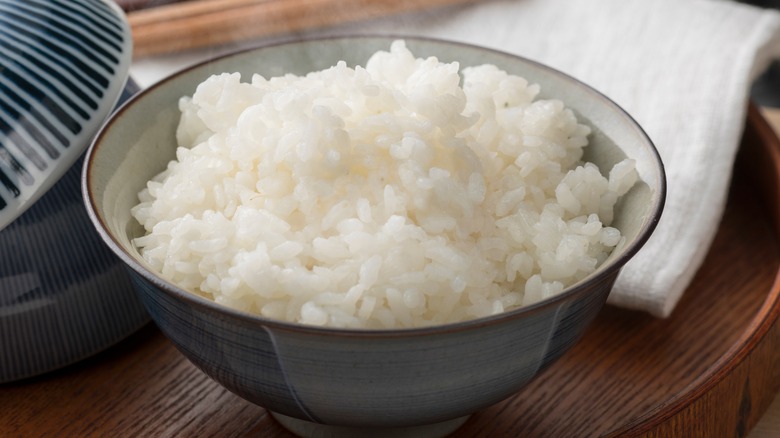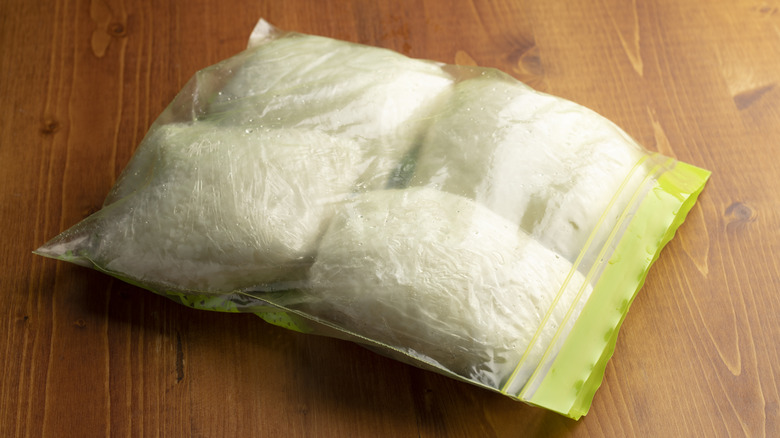How To Reheat Frozen Rice To Get A Fluffy Finish Each Time
Did you know that you can freeze cooked rice? It's a handy kitchen hack for various reasons, and our favorite reason by far is that it's straightforward to reheat. But there are steps you must take to get a fluffy finish each time.
First, don't thaw frozen rice in the fridge, which can affect its texture. Think of how frozen peas thaw: The ice in the peas melts and creates a puddle that your now unevenly reconstituted peas are soaking in. A similar process happens with cooked rice, and the starch gives you gummy rice that won't be as pleasant to eat.
So what do you need to do? Simply microwave it on high for 2-3 minutes. The water melts out of the rice, then steams it back to its perfect shape. Easy-peasy! If you don't have a microwave, you can heat frozen rice on the stovetop (depending on how your rice was frozen in the first place). Just add a bit of water to the pan to account for evaporation, and remember to stir the rice until it's heated through so it doesn't stick to the pan.
If you're adding rice to soups, stews or frying it for this easy fried rice, you can add it straight from the freezer. Add an extra minute to the cooking time to ensure the rice is completely warmed.
How to freeze rice
How do you freeze rice in the first place? There are two ways, depending on how you foresee using the rice. If you plan to eat the rice plain as a side with your meal, you can follow chef David Chang's mom's lead: portion into neat little rice pillows, wrap in plastic, then place in a freezer-safe container before freezing. This way, you can easily microwave it according to the portions needed. This is also useful if you add the rice straightaway into the dish you're cooking, as it will thaw and mix into the dish simultaneously.
If you foresee frying the rice, or if you are only able to reheat the rice on the stovetop, we recommend a different method. First, spread the cooked rice in an even layer on a sheet tray and let it cool for about 20 minutes. Then scoop the rice into containers to be frozen, but don't pack it in the same way as the previous method. This way, you won't have to deal with a little boulder of frozen rice, and it will be easy to break up when reheating.
You can also freeze prepared rice dishes. Have you already fried the rice or made a rice casserole? No problem. Portion the dishes, freeze them separately, and reheat them as needed. This makes meal prep a breeze, especially when combined with freezing stews and braises for future meals.
Why do we need to freeze rice at all?
There are several important reasons to freeze rice apart from the obvious meal prep benefits. The most urgent reason is that improperly stored cooked rice can cause food poisoning. England's National Health Service states, "Uncooked rice can contain spores of Bacillus cereus ... [which] can survive when rice is cooked." These spores can grow into bacteria at room temperature or in the uneven temperatures that home refrigerators are usually subject to, especially with the frequent opening and closing of their doors.
Freezing rice can also be beneficial for those needing to reduce dietary sugar. In a study by researchers in China and Guyana, the glycemic index of cooked and then frozen rice was found to be lower than freshly steamed rice. This is because the way starches in the rice freeze makes them resistant to digestion in our gut.
You can also freeze uncooked rice to extend its shelf life. It's a surefire way of keeping rice weevils at bay; plus, if you usually consume brown (unmilled) rice, it contains oils that can become rancid when left at room temperature for too long.


